
... and the real Morocco
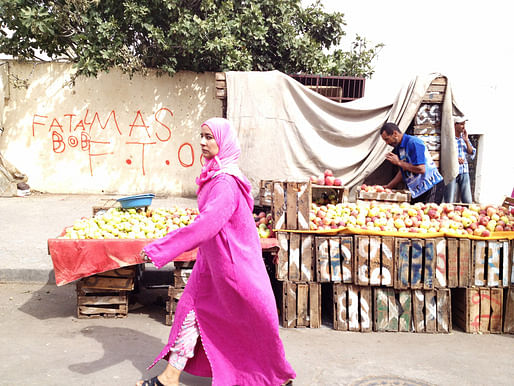 Fes street market, outside the old medina
Fes street market, outside the old medina
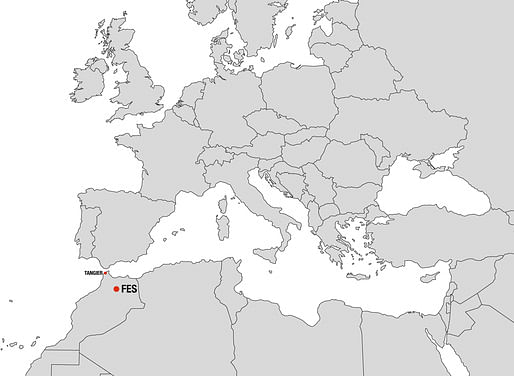
My bus arrived in Fes at 5:30 in the morning, where Dany (aka, Abdulraheem) was waiting to meet me, although we were more than 30 minutes late. Dany’s brother-in-law, who had approached me in the Tangier bus terminal the night before under the guise of a ‘tourism officer’, helped make the transport arrangements. I didn’t exactly have a better plan.
Dany’s ‘taxi’ turned out to be a Toyota Land Cruiser, complete with a roof rack and one of those giant chrome bumpers that always make me think the driver is prepared to hit a moose, or in this case, more likely a donkey. I wanted nothing more than to find my hostel and crash, but when Dany asked where I was staying, he just laughed.
“Do you know there are 9,376 streets in the medina? You’ll never find it in the dark.”
“Yeah, but I have a map cached on my phone. I’ll be fine.”
“What?”
“Nevermind. I’m sure it will be okay. Please just drop me off at the Blue Gate.”
I woke up the next morning on Dany’s couch, after he basically refused to let me go to that ‘shitty tourist trap’ of a hostel that I had booked online. Apparently the owner has a reputation. I didn’t exactly trust Dany’s opinion, even after his seemingly genuine hospitality, but I was trying hard to be congenial. “Good things happen to good people” he said. “Allah sent you to me.”
This didn’t ease my anxiety about being kidnapped, but I was willing to go along with it, for now. He called to make me a reservation at a modest hotel, and I listened carefully to try to decipher what he was saying in Arabic. I don’t speak more than a few words of Arabic, but it sounded legit. I’m embarrassed about my hesitation now, but who knows? I’ve seen too many movies.
For some reason, Dany was insistent that I experience the ‘real’ Morocco, not the packaged tourist version that you might book-in-advance. Like the hostel, he refused to take me to the Moroccan cooking class I had booked in order to get an inside view of the medina. He insisted that it was not only a rip-off, but that I would probably end up in the hospital with food poisoning.
I was still tentative, and honestly yearning to just be left alone, when he dropped me off in the medina that morning to meet his cousin Aziz, who was to be my personal substitute for the cooking class. Five minutes later I felt like the luckiest white person in Fes, cruising through the streets with Aziz, who knew where he was going - dodging donkey-carts, women carrying baskets of vegetables or babies or both, kids playing tag, a guy welding - it was a mad frenzy of people dashing about everywhere. Aziz greeted just about every other person we passed, “Salam hiacham”, without relaxing his hasty pace, and they all replied respectfully in return. We rested to sip a cup of mint tea and, grinning, he confided, “I’m the king of the Fes medina.” There was nothing to do but agree.
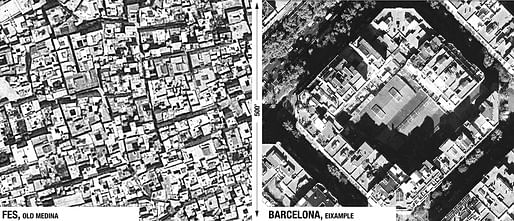 Urban scale comparison: The Fes medina and my former apt. block in Barcelona
Urban scale comparison: The Fes medina and my former apt. block in Barcelona
 View from the roof of Aziz's house
View from the roof of Aziz's house
Most people you might meet (if you stand out like I do) in a Moroccan medina, will offer to show you around (usually from one shop to the next where they make commission on whatever you buy), and then ask for an outlandish tip after you buy them lunch. But Aziz didn’t claim to work for the ‘tourism office’. He is an elementary school teacher, has lived amidst the 9,376 streets of the medina every one of his 48 years. Besides, his sister makes the best Moroccan food that money can’t buy.
The streets of the Fes medina are just barely wide enough for two people (or one donkey cart) to pass. Otherwise it’s a traffic jam. So it’s always a traffic jam, and it’s a ridiculous maze. Even with the map, I never would have found my hostel that first night. The buildings all lean over the street slightly, and with clothes and wires and textiles strung overhead, it almost feels like you’re inside.
The largest souk in Fes starts at the confluence of two streets that form a sort of plaza, and like the messy current of two rivers coming together, the flow of people slowed as everyone’s attention turned to the food; an exotic myriad of meat, spices, fish, fruits and vegetables, all overflowing into the streets and beckoning from the tops of counters. The Fes souks are basically street markets, vendors in tiny shops or tables on either side, and the flow is linear on a single street, which might be like any other except for the activity. In some places the street is covered, by overlapping textiles or bamboo, to give a sense of enclosure and protect the meat from spoiling in the sun, where it would otherwise reach the street for at least a few minutes each day. In other places it is open. (By contrast, the streets of the souks in the Tunis medina are completely covered by vaulted ceilings, and generally less chaotic.)
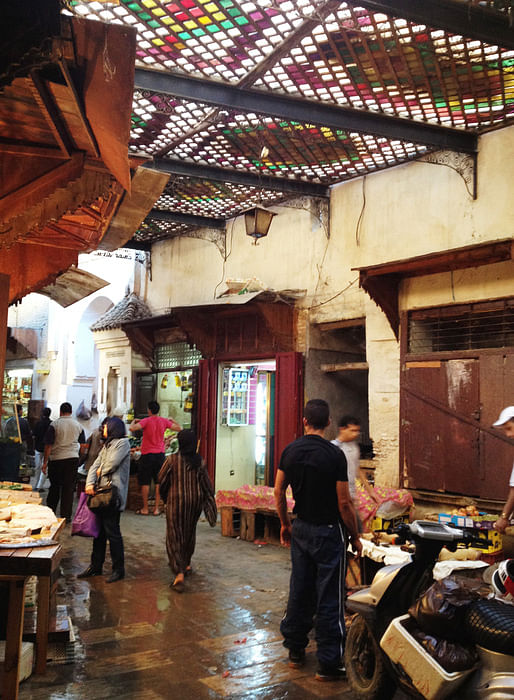 'Plaza' in Fez souk
'Plaza' in Fez souk
 Fish vendor in Fez souk, where we bought shark fillets called rokan. I've looked this up, but can't find the English translation. Anybody?
Fish vendor in Fez souk, where we bought shark fillets called rokan. I've looked this up, but can't find the English translation. Anybody?
 Woven textiles and reed coverings over the streets in the Fez souk
Woven textiles and reed coverings over the streets in the Fez souk
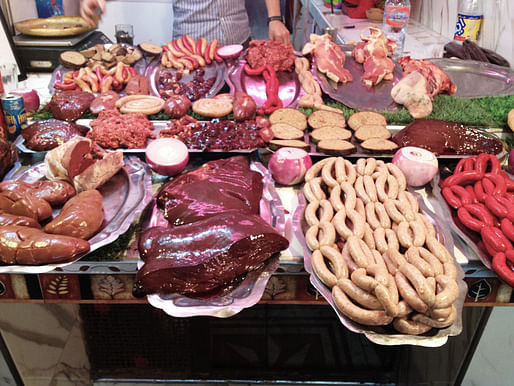 Meat vendor
Meat vendor
There are rare price tags on food in the Fes souks. Negotiation is the standard procedure, and with Aziz doing the talking, we purchased everything we would need for a glutonous feast, with about $12 (+/- 100 Moroccan dirhams). Upon arriving at his house, an ancient ‘dar’ (constructed in 1329 kind of ancient), Aziz explained the concept of the traditional Moroccan tajine, as his sister Fatima demonstrated the technique. Admittedly, I didn’t follow his explanation at first, perhaps because tajine refers not to a particular recipe, but a type of preparation - like sauce or soup. Tajine is basically a stew made from seemingly any combination of meat, vegetables and Moroccan spices, although the base is usually tomato with boiled potatoes and carrots. To complicate matters, the traditional clay pot in which the tajine is made is also called a tajine, so in any given sentence during the course of my lesson, tajine became both subject and object and sometimes, inexplicably, the verb as well.
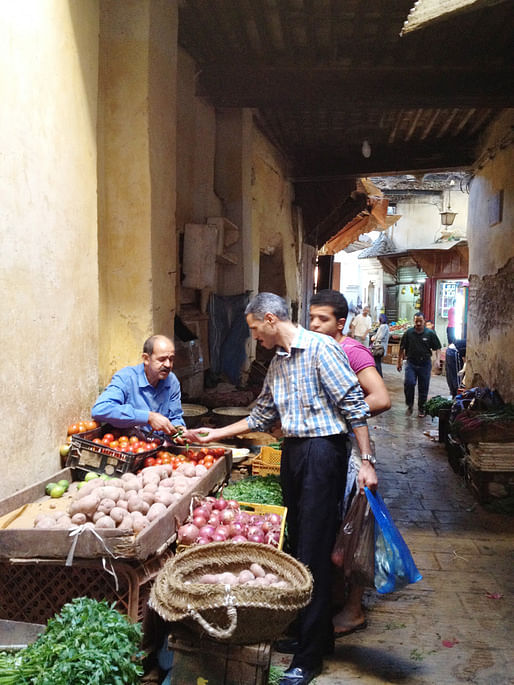 Aziz haggling over the price of tomatoes in the Fez souk
Aziz haggling over the price of tomatoes in the Fez souk
Since I know you’ll be curious, the recipe is included below. I would try to describe the flavors to you, but food writing isn’t really my thing. No descriptive metaphor, whether in reference to dancing, or explosions, or sex, or Christmas morning, could properly describe my delight at the first bite. Let it suffice to say that it was delicious. I wanted to savor the meal, the moment, the luck of this encounter, everything, but every time I stopped for a breath I was prodded along. “Eat”, he demanded. “Ok, I’m eating”, I replied, with food in my mouth. “Mange, mange, mange”, insisted Fatima, in French. Was I being fattened up for the killing, like a half-suspecting turkey? No, I was just being hosted by a real Moroccan family.
“You won’t find tajine like this in any restaurant”, Aziz said. “And you won’t end up in the hospital either.”
“That’s comforting.”
As I crawled into bed late that evening, after Aziz took me to watch the Moroccan national team qualify for the African Cup in a dramatic 4-0 upset over Mozambique, it was comforting. And for the first time in days, I slept.
Shark (rokan) tajine
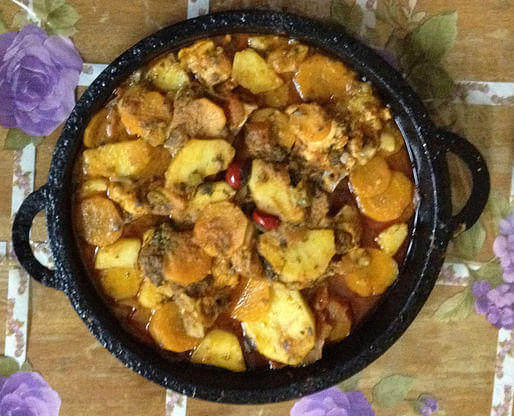
What you'll need (there was no measuring, so amounts are estimated):
3-4 potatoes
half a dozen carrots
3-4 tomatoes
a handful of cilantro
2-3 garlic cloves
1 tsp. salt
2 lemons
1 tbsp. paprika
1 tbsp. cumin
1/2 cup of water
9-10 oz can of crushed tomatoes
1 red onion
olive oil
shark fillets (or substitute); about 3x6" pieces
The process:
1. Quarter the potatoes and slice the carrots. Boil together with olive oil for about 15 minutes.
2. The sauce: Pistle-grind or blend the cilantro, garlic, lemon juice, salt, paprika and cumin. In a mixing bowl, stir in the can of crushed tomatoes and grate (juice) 2-3 fresh tomatoes. Add 1/2 cup of water. Adjust salt and spices to taste.
3. Slice 1/4" pieces of the red onion and one tomato, and put in a frying pan, or if you have one, a traditional tajine. (Fatima used a frying pan, so don't sweat it). Add olive oil (liberally).
4. By now your potatoes and carrots should be done. Transfer half of the boiled mix over the bed of tomato and onion in the frying pan.
5. Dip the fish fillets in the sauce, and put them in the frying pan.
6. Cover the fish with the second half of the boiled potato/carrot mix.
7. Pour the sauce over everything.
8. Simmer on medium heat for 25 minutes, stirring occassionally.

Section through frying pan, for reference
Enjoy! Thanks for reading

Fatima grinding ingredients for the tajine sauce
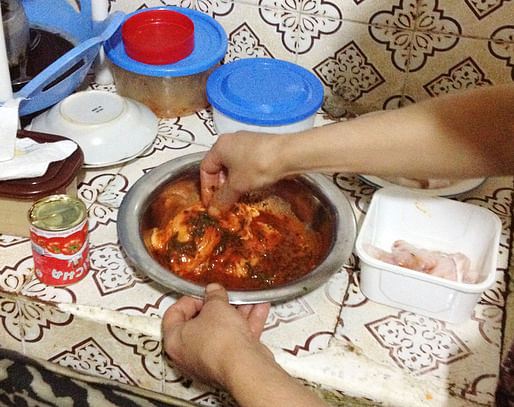
Dipping the shark in the sauce before putting it in the frying pan

The source of food (excluding the shark), just outside of Fes
I am a graduate M.Arch/MLA student at UC Berkeley, and grateful recipient of the 2011-2012 John K. Branner Fellowship, an annual traveling fellowship awarded by the UC Berkeley Department of Architecture. I will spend the 2012 calendar year visiting public food markets in major cities on 5 continents to research the relationship between markets and the infrastructure of food systems, focusing on the cultural and urban design implications of local economies. This blog will follow my journey...



2 Comments
had you eaten shark before?
First time! that I can remember. And just to clarify in case any PETA sympathizers take offense, it wasn't just the fin...
Block this user
Are you sure you want to block this user and hide all related comments throughout the site?
Archinect
This is your first comment on Archinect. Your comment will be visible once approved.